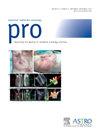在使用 CFR-PEEK 器械的患者术后 RT 计划中使用 MRI。
IF 3.5
3区 医学
Q2 ONCOLOGY
引用次数: 0
摘要
背景和目的:碳纤维增强型 PEEK 器械在脊柱肿瘤领域的应用越来越广泛。使用这种材料可以获得更好的可视化效果,从而可以使用 CT 髓鞘造影术或核磁共振成像研究进行更精确的术后立体定向体放射治疗(SBRT)规划。我们比较了剂量规划的等效性和结果:方法:我们对 306 例连续接受治疗的患者进行了回顾性研究,这些患者在 2022 年 1 月 1 日至 2023 年 3 月 4 日期间使用 CFR-PEEK 器械对脊柱转移瘤进行了脊柱融合术,术后接受了 SBRT。根据术后 SBRT 计划使用的成像模式(MRI 与 CT-髓鞘造影),患者被分为两组。收集了手术、人口统计学、术后放射剂量测定、并发症和生存数据。统计分析在 SPSS(v29.0.1.0)中进行:11名患者接受了CT-髓鞘造影,25名患者接受了磁共振脊柱成像以进行SBRT计划。中位随访时间为 145.5 天 [13-530]。MRI脊柱成像组和CT髓鞘造影组在基线人口统计学、手术特征或SBRT剂量学方面没有明显差异。两组患者的生存率无明显差异(P=0.402):结论:磁共振扫描是使用CFR-PEEK器械进行肿瘤脊柱融合术的患者术后SBRT轮廓扫描的有效选择。结论:磁共振扫描是使用CFR-PEEK器械进行肿瘤性脊柱融合术的SBRT术后轮廓扫描患者的有效选择,避免了CT脊髓造影,减少了侵入性手术的需要和潜在风险,包括CSF渗漏、神经根损伤和增加的手术负担。本文章由计算机程序翻译,如有差异,请以英文原文为准。
Use of Magnetic Resonance Imaging for Postoperative Radiation Therapy Planning in Patients with Carbon Fiber-Reinforced Polyetheretherketone Instrumentation
Purpose
Carbon fiber-reinforced polyetheretherketone (CFR-PEEK) instrumentation is being used more frequently in the spinal oncology landscape. Better visualization with this material allows for more precise postoperative stereotactic body radiation therapy (SBRT) planning using either computed tomography (CT)-myelography or magnetic resonance imaging (MRI) studies. We compared the dosimetric planning equivalencies and outcomes.
Methods and Materials
Thirty-six consecutively treated patients were reviewed who underwent spinal fusion using CFR-PEEK instrumentation for spine metastases followed by postoperative SBRT between January 1, 2022, and April 3, 2023. Patients were divided into 2 cohorts based on the imaging modality, MRI versus CT-myelogram, used for postoperative SBRT planning. Surgical, demographic, postoperative radiation dosimetry, complication, and survival data were collected. Statistical analysis was performed in SPSS (v29.0.1.0).
Results
Eleven patients underwent CT-myelograms, and 25 patients underwent MR-spine imaging for SBRT planning. The median follow-up was 145.5 days (13-530). There were no significant differences between baseline demographic, surgical characteristics, or SBRT dosimetry between the MRI spine and CT-myelogram groups. There was no significant difference between the cohorts for survival (P = .402).
Conclusions
MR scans are an effective choice for postoperative SBRT contouring patients using CFR-PEEK instrumentation for oncologic spinal fusions. Avoidance of CT-myelography reduces the need for an invasive procedure and potential risks including cerebrospinal fluid (CSF) leak, nerve root injury, and increased procedural burden.
求助全文
通过发布文献求助,成功后即可免费获取论文全文。
去求助
来源期刊

Practical Radiation Oncology
Medicine-Radiology, Nuclear Medicine and Imaging
CiteScore
5.20
自引率
6.10%
发文量
177
审稿时长
34 days
期刊介绍:
The overarching mission of Practical Radiation Oncology is to improve the quality of radiation oncology practice. PRO''s purpose is to document the state of current practice, providing background for those in training and continuing education for practitioners, through discussion and illustration of new techniques, evaluation of current practices, and publication of case reports. PRO strives to provide its readers content that emphasizes knowledge "with a purpose." The content of PRO includes:
Original articles focusing on patient safety, quality measurement, or quality improvement initiatives
Original articles focusing on imaging, contouring, target delineation, simulation, treatment planning, immobilization, organ motion, and other practical issues
ASTRO guidelines, position papers, and consensus statements
Essays that highlight enriching personal experiences in caring for cancer patients and their families.
 求助内容:
求助内容: 应助结果提醒方式:
应助结果提醒方式:


